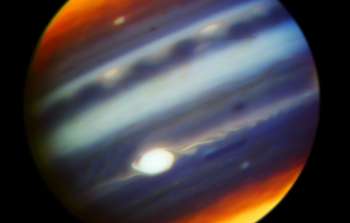sci17081 — Announcement
Gemini and Subaru Observatories Support Juno Science
July 11, 2017
Composite color infrared image of Jupiter (left) reveals haze particles over a range of altitudes, as seen in reflected sunlight. The image, consisting of 5 bands, used the Gemini North telescope with the Near-InfraRed Imager (NIRI) on May 18, 2017, one day before the Juno mission’s sixth close passage (“perijove”) of the planet. At longer infrared wavelengths (right), Jupiter glows with thermal emission at 4.8-micron image. This image, obtained with the Gemini North telescope’s Near-InfraRed Imager (NIRI), was obtained on January 11, 2017, so the relative positions of discrete features have changed with respect to the near-infrared image at left.
Detailed Gemini Observatory infrared images peel back Jupiter’s atmospheric layers to support the NASA/JPL Juno spacecraft in its quest to better understand Jupiter’s atmosphere.
As the Juno spacecraft prepares for its close passages of Jupiter, Gemini and the Subaru observatories on Maunakea are acquiring high-resolution imaging of Jupiter to identify compelling features for close-up study as shown below. “The Gemini observations, spanning most of the first half of this year, have already revealed a treasure-trove of fascinating events in Jupiter’s atmosphere,” said Glenn Orton, PI for this Gemini program, which includes adaptive optics imaging. Orton is coordinator for Earth-based observations supporting the Juno project at Caltech’s Jet Propulsion Laboratory.
For more details see the Gemini press release.
About the Announcement
| Id: |
ID
sci17081
|


